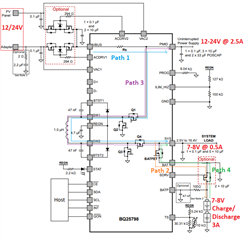Tool/software:
Hello TI team,
I’m working on a power supply concept utilizing the BQ25798 and have some questions regarding the IC’s capabilities.
In my design, there are three distinct power sources: a 12V or 24V DC adapter from the grid or PV panel, and an internal 2S2P battery pack.
As shown in the attached image, there are four power paths that I need to manage with the following priority:
- When a valid source is available on the VBUS input, Path 1 should be active.
- If battery charging is needed, Path 2 should activate in parallel with Path 1.
- When no valid source is present on VBUS, both Path 3 and Path 4 should be active.
- Path 4 should be switchable (ON/OFF) over extended periods to maximize battery autonomy.
Could you confirm if this concept is feasible with the BQ25798, or suggest any adjustments if needed?
Thank you for your assistance with this.


